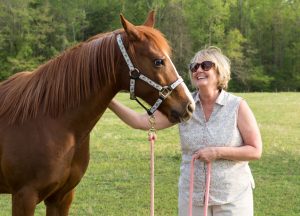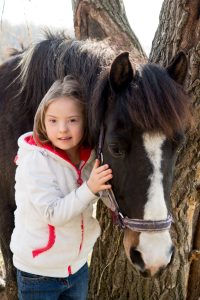 The bond between people and horses is a strong one. Over the millennia, this interspecies relationship has evolved from one of equine servitude as a beast of burden to one in which horses share our lives in a much more intimate and integral way.
The bond between people and horses is a strong one. Over the millennia, this interspecies relationship has evolved from one of equine servitude as a beast of burden to one in which horses share our lives in a much more intimate and integral way.
Cowboys in the West still rely on their trusty Quarter Horses to wrangle livestock. Equestrians all across the world breed, train, and compete with their four-legged athletic partners. And young children still fall in love with the idea of someday having a pony of their very own. Even people who have never ridden a horse can enjoy the animal’s majestic beauty.
Horses also often take on therapeutic roles. Dating back to Ancient Greece, equine therapy has long been used to treat a variety of physical ailments including cerebral palsy, behavioral tics, motor control issues, and coordination problems.
Today, horses routinely help people across a wide spectrum of special needs including ADD/ADHD, autism, Asperger’s, behavioral disorders, learning difficulties, depression, cerebral palsy, Down syndrome, visual and hearing impairments, muscular dystrophy, and more.
What’s especially exciting right now is that, for the first time, data from scientifically designed research into the efficacy of Equine-assisted Therapy (specifically with children who have autism) is showing that the therapy has clear, lasting benefits.
What is Equine-assisted Therapy?
There are many different types of horse-related therapies to address a range of special needs. As a still-emerging area of treatment and study, there are many different labels you might come across, including:
- therapeutic horseback riding;
- hippotherapy (“hippo” is the Ancient Greek word for horse)
- Equine-assisted Therapy (EAT);
- Equine-assisted Learning (EAL); and
- Equine-assisted Psychotherapy (EAP).
You may also hear the term “Equine-assisted Activities” (EAA) as an umbrella term to cover a range of horse-related therapeutic practices. Each of these terms refers to a nuanced approach to working with horses in a therapeutic way.
The American Hippotherapy Association defines a few of the most commonly used terms as follows:
Adaptive Riding (AR) Mounted activities, including traditional riding disciplines (i.e. English, Western) where instruction and/or equipment may be modified by a specially trained riding instructor for a person with a disability to ensure successful progression of equestrian skills. (Note: This is sometimes also referred to as Therapeutic Riding. It is generally considered recreational and is not covered by insurance.)
Equine-assisted Therapy (EAT) is a goal-directed intervention in which a specially trained equine is an integral part of the treatment process. EAT is directed and/or provided by a human/health service professional with specific expertise and within the scope of their practice.
Hippotherapy (HPOT) is a physical, occupational, or speech therapy treatment strategy that utilizes equine movement. This strategy is used as part of an integrated treatment program to achieve functional outcomes.
Depending on the type of therapy, the experience may include mounted and/or unmounted activities. Riding activities may be done with a single student and a single teacher, or they may involve additional therapists with specialized physical or emotional expertise. In addition to riding, students may spend time grooming horses and participating in other barn-related tasks that are designed to help students focus, follow directions, cooperate, engage specific motor skills, and manage emotions.
How does it help?
Working with horses in a therapy program provides all kinds of physical, emotional, and social benefits.
For people with physical disabilities, riding horses has been shown to improve balance, muscle tone, coordination, and motor control. Horseback riding is an activity that engages a person’s body in all three dimensions: forward and back, up and down, and side to side. This multi-dimensional movement is similar to the way we walk—swinging our arms, moving our hips, and extending our legs forward and back—and it can help the rider build muscle memory that helps with unmounted movement.
 For people with autism, Asperger’s, and a variety of behavioral disorders, working with horses can open up the world and encourage new connections and experiences. For instance, children with autism often find it difficult to establish emotional bonds. They find it uncomfortable to make eye contact, and often have challenges around basic communication and self expression. Horses offer an opportunity to connect through non-verbal communication in a calm and non-threatening way. They can also help teach children about non-verbal social cues.
For people with autism, Asperger’s, and a variety of behavioral disorders, working with horses can open up the world and encourage new connections and experiences. For instance, children with autism often find it difficult to establish emotional bonds. They find it uncomfortable to make eye contact, and often have challenges around basic communication and self expression. Horses offer an opportunity to connect through non-verbal communication in a calm and non-threatening way. They can also help teach children about non-verbal social cues.
Horse-based activities can also help with the development of cognitive and language skills. Working with horses is a highly engaging activity that inspires focus and attention. Specialists working with learners and horses often integrate specific therapeutic exercises into the equine sessions. For example, children might be asked to perform certain tasks while riding, like throwing a ball or identifying certain objects.
The truth is, we are still learning all the ways equine therapies can help people with special needs. But the more we learn, the more hopeful things look.
In 2015, Robin L. Gabriels—a psychologist working at Children’s Hospital Colorado—ran a groundbreaking study on how therapeutic horseback riding affected children with autism. The study, since published in a medical journal, found that children and teens with autism who rode horses showed improvements in speech, social skills, hyperactivity, and irritability as compared to a control group of study participants who did not ride. Importantly, most of these improvements were still evident six months after the study.
As a result of the findings from this original research and some follow-up studies, Gabriels was recently awarded a $2.5 million federal grant to fund an additional five-year study. The new study, which will run out of riding facilities in Colorado and Maine, will focus on youth who have both autism and a psychiatric condition such as ADHD, depression, or anxiety.
Who is it for?
In addition to being beneficial for children and adults with a wide range of physical, cognitive, and behavioral needs, equine-assisted therapies have also been used to successfully help in the treatment of people with depression, PTSD, anxiety, and substance abuse issues.
From the physical to the emotional elements involved with being around and riding horses, equine therapies offer a multi-faceted approach to treating a number of disparate conditions.
Equine-assisted therapies are even being used to help people with dementia. The first published study on how time spent with horses affects adult Alzheimer’s patients came about as the result of a multi-department collaboration at Ohio State University.
A statement on the university’s website summarizes the study’s findings, “The results showed that spending time with horses had noticeable benefits for patients, including better moods and increased physical activity. Researchers saw clear signs that patients enjoyed their time on the farm: they smiled, laughed and talked to the horses. Those who normally acted withdrawn or upset became fully engaged in the experience.” And then other studies followed, at Stanford University and UC Davis, to name just a couple.
 Where can you access equine-assisted therapies?
Where can you access equine-assisted therapies?
If you are interested in getting more involved with therapeutic horse-related activities, there are a number of Connecticut-based programs to explore. Here are just a few:
- Ebony Horsewoman is located in historic Keney Park right in Hartford. Founded in 1984 by Patricia E. Kelly, a U.S. Marine Corp Vietnam-era veteran and African-American cowgirl, this facility started with a dream to level the playing field for inner-city youth. Today, Ebony Horsewoman, Inc. (EHI) has become the regional leader in providing Culturally Competent Equine Assisted Therapy and Psychotherapy.
- High Hopes, located in Old Lyme, grew from a group of nomads with borrowed horses to a leader in therapeutic riding services as well as professional education and training in the industry. In addition to therapeutic riding, they also offer therapeutic carriage driving and unmounted equine learning programs.
- Hidden Acres was founded in 2008 by Mary and Theron Simons. Located on 81 acres in Naugatuck, the stable is a PATH (Professional Association of Therapeutic Horsemanship) member that has helped hundreds of program participants. They offer a full range of equine-assisted activities and therapies as well as garden and nature programs.
If you’d like to take an inside look at what different kinds of equine-assisted therapies look like and how they change people’s lives, filmmaker David Block’s short documentary, Gift Horses, provides a window onto several different human-horse relationships and how those relationships have provided healing, enhanced learning, and improved quality of life.
Equine related therapy is just one of several options available for individuals with special needs. For more ideas refer to one of our related blog posts below. And, if you ever need to consult with one of our attorneys regarding appropriate legal planning for your loved one with special needs, we’re here to help.
Related Posts:
How Pet-assisted Therapy Helps Dementia Patients
Staying Connected through Melodies: Music and Dementia
 Connecticut Estate Planning Attorneys Blog
Connecticut Estate Planning Attorneys Blog


